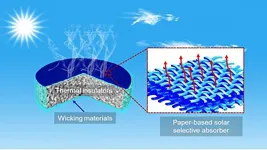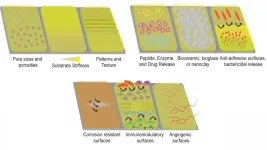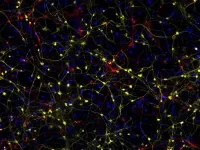Solar-powered desalination unit shows great promise
Scientists develop a low-cost, highly efficient technique that uses solar energy to remove salt from seawater, producing safe drinking water.
2021-04-27
(Press-News.org) WASHINGTON, April 27, 2021 -- Despite the vast amount of water on Earth, most of it is nonpotable seawater. Freshwater accounts for only about 2.5% of the total, so much of the world experiences serious water shortages.
In AIP Advances, by AIP Publishing, scientists in China report the development of a highly efficient desalination device powered by solar energy. The device consists of a titanium-containing layer, TiNO, or titanium nitride oxide, capable of absorbing solar energy. The TiNO is deposited on a special type of paper and foam that allows the solar absorber to float on seawater.
When sunlight strikes the titanium layer, it heats rapidly and vaporizes the water. By placing the unit in a transparent container with a sloped quartz roof, the water vapor can be condensed and collected, producing a copious amount of freshwater.
"In the solar energy field, TiNO is a common commercial solar absorbing coating, widely used in solar hot water systems and in photovoltaic units," author Chao Chang said. "It has a high solar absorption rate and a low thermal emittance and can effectively convert solar energy into thermal energy."
The investigators developed a method for depositing a layer of TiNO using a technique known as magnetron sputtering. They used a special type of highly porous paper known as airlaid paper that acts as a wicking material to supply water from the seawater reservoir. Airlaid paper is made from wood fibers and is commonly used in disposable diapers.
The evaporation unit included three parts: the TiNO layer on top, a thermal insulator, and the airlaid paper on the bottom. The insulation layer is polyethylene foam, which has many air-filled pores that trap heat and allow the multi-layer unit to float on top of a reservoir of seawater, minimizing heat loss to the surroundings.
"The porous airlaid paper used as the substrate for the TiNO solar absorber can be reused and recycled more than 30 times," said Chang.
Salt precipitation on the TiNO surface could interfere with efficiency, but the investigators found even after a long time, no salt layer formed on the surface. They suggest the porous nature of the paper wicks away any salt that might form on the surface, returning it to the seawater reservoir.
The salinity of ordinary seawater is over 75,000 milligrams of salt per liter. Ordinary drinking water has a salinity of about 200 milligrams per liter. The desalination unit was able to decrease the seawater salinity to less than 2 milligrams per liter.
The combination of low cost, high efficiency, and lack of fouling for this desalination technology shows it has the potential to help solve the world's freshwater shortage.
INFORMATION:
The article "Porous TiNO solar-driven interfacial evaporator for high-efficiency seawater desalination" is authored by Chao Chang, Min Liu, Lilin Pei, Guowei Chen, Zongyu Wang, and Yulong Ji. The article will appear in AIP Advances on April 27, 2021 (DOI: 10.1063/5.0047390). After that date, it can be accessed at https://aip.scitation.org/doi/10.1063/5.0047390.
ABOUT THE JOURNAL
AIP Advances is an open access journal publishing in all areas of physical sciences--applied, theoretical, and experimental. The inclusive scope of AIP Advances makes it an essential outlet for scientists across the physical sciences. See https://aip.scitation.org/journal/adv.
[Attachments] See images for this press release:

ELSE PRESS RELEASES FROM THIS DATE:
2021-04-27
WASHINGTON, April 27, 2021 -- Traffic accidents, tumor resections, and congenital diseases can cause significant trauma, which can lead to large bone deformations and/or bone loss. Although bone has some capacity to regenerate, large bone defects cannot be healed without major medical procedures.
In these situations, metallic implants are widely used, but the bioinertness of such implants poses a major challenge in bone tissue engineering. Bioinert metal implants lack bone integration, loosen over time, and may lead to adverse reactions around the area in which ...
2021-04-27
LA JOLLA--(April 27, 2021) Despite the prevalence of Alzheimer's, there are still no treatments, in part because it has been challenging to study how the disease develops. Now, scientists at the Salk Institute have uncovered new insights into what goes awry during Alzheimer's by growing neurons that resemble--more accurately than ever before--brain cells in older patients. And like patients themselves, the afflicted neurons appear to lose their cellular identity.
The findings, published April 27, 2021, in the journal Cell Stem Cell, showed that these brain cells are characterized by markers of stress as well as changes in which the cells become less specialized. ...
2021-04-27
The research was conducted at the Department of Food Science at the University of Copenhagen (UCPH FOOD) with professor emeritus Lars Munck as coordinator and builds on earlier work since 1963 at Svaloef Plant Breeding Institute and the Carlsberg Laboratory.
A complete picture of the organism
The research shows how, with the help of a fast, non-destructive and green analysis method, near-infrared spectroscopy (NIRS), we can obtain a global overview that mirrors how the entire chemical composition of nutrients in a barley grain is changed, for example, by a mutation in a single gene. This is in contrast to current ...
2021-04-27
Muscle weakness in patients with Becker disease is caused by unusual electrical activity in muscle fibres termed 'plateau potentials' that make them temporarily inactive, says a study published today in eLife.
An understanding of these mechanisms and the ion channels involved may help the search for more effective therapies for weakness in Becker disease and other muscle diseases, and help understand how electrical activity is regulated in muscles.
Recessive myotonia congenita, also known as Becker disease, is a heritable skeletal muscle disease caused by mutated chloride ...
2021-04-27
New interfacial superconductor has novel properties that raise new fundamental questions and might be useful for quantum information processing or quantum sensing.
Interfaces in solids form the basis for much of modern technology. For example, transistors found in all our electronic devices work by controlling the electrons at interfaces of semiconductors. More broadly, the interface between any two materials can have unique properties that are dramatically different from those found within either material separately, setting the stage for new discoveries.
Like semiconductors, superconducting materials have many important implications for technology, from magnets for MRIs to speeding up electrical connections or perhaps making possible quantum technology. The ...
2021-04-27
WASHINGTON, April 27, 2021 -- If a base station in a local area network tries to use a directional beam to transmit a signal to a user trying to connect to the network -- instead of using a wide area network broadcast, as base stations commonly do -- how does it know which direction to send the beam?
Researchers from Rice University and Brown University developed a link discovery method in 2020 using terahertz radiation, with high-frequency waves above 100 gigahertz. For this work, they deferred the question of what would happen if a wall or other reflector nearby creates a non-line-of-sight (NLOS) path from the base station to the receiver and focused on the simpler situation where ...
2021-04-27
The COVID-19 vaccine isn't having any trouble attracting suitors.
But there's another, older model that's been mostly ignored by the young men of America: the HPV vaccine.
Using data from the 2010-2018 National Health Interview Surveys, Michigan Medicine researchers found that just 16% of men who were 18 to 21 years old had received at least one dose of the HPV vaccine at any age. In comparison, 42% of women in the same age bracket had gotten at least one shot of the vaccine.
The CDC's Advisory Committee on Immunization Practices recommends two doses of the vaccine ...
2021-04-27
WINSTON-SALEM, NC - April 27, 2021 -- An intestinal bowel disease that affects up to 10 percent of premature infants at a very vulnerable and developmentally crucial time can lead to serious infection and death. Scientists at the Wake Forest Institute for Regenerative Medicine (WFIRM) are tackling the disease with a human placental-derived stem cell (hPSC) therapy strategy that is showing promising results.
Necrotizing enterocolitis is a life-threatening intestinal disease that is a leading cause of mortality in premature infants and treatment options remain elusive. The ...
2021-04-27
Abu Dhabi, UAE, April 27, 2021: As people around the world increasingly get their news from social media, online misinformation has emerged as an area of great concern. To improve news literacy and reduce the spread of misinformation, NYUAD Center for Cybersecurity researcher and lead author Nicholas Micallef is part of a team that designed Fakey, a game that emulates a social media news feed and prompts players to use available signals to recognize and scrutinize suspicious content and focus on credible information. Players can share, like, or fact-check individual articles.
In a new study, Fakey: A Game Intervention to Improve News Literacy on Social Media published in the ACM Digital Library, Micallef and his colleagues ...
2021-04-27
Aerosol products used in the home now emit more harmful volatile organic compound (VOC) air pollution than all the vehicles in the UK, new research shows.
A new study by the University of York and the National Centre for Atmospheric Science reveals that the picture is damaging globally with the world's population now using huge numbers of disposable aerosols - more than 25 billion cans per year.
This is estimated to lead to the release of more than 1.3 million tonnes of VOC air pollution each year, and could rise to 2.2 million tonnes by 2050.
The chemicals now used in compressed aerosols ...
LAST 30 PRESS RELEASES:
[Press-News.org] Solar-powered desalination unit shows great promise
Scientists develop a low-cost, highly efficient technique that uses solar energy to remove salt from seawater, producing safe drinking water.







